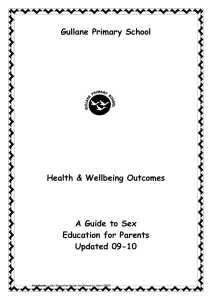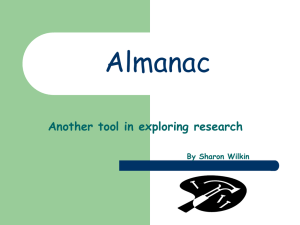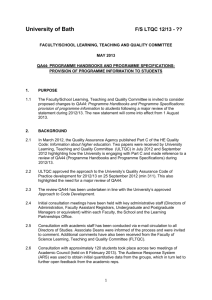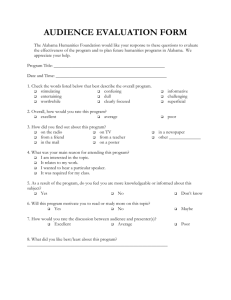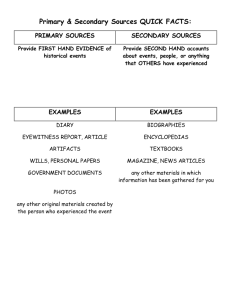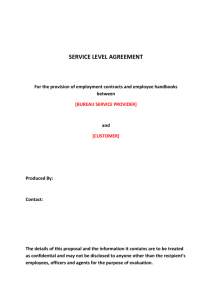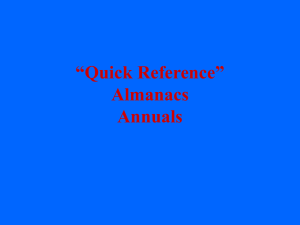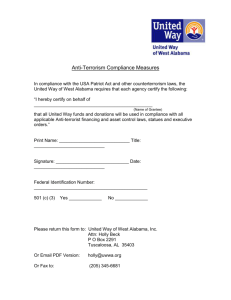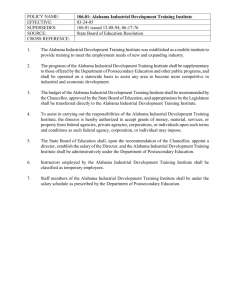HANDBOOKS AND DIRECTORIES EXERCISES
advertisement
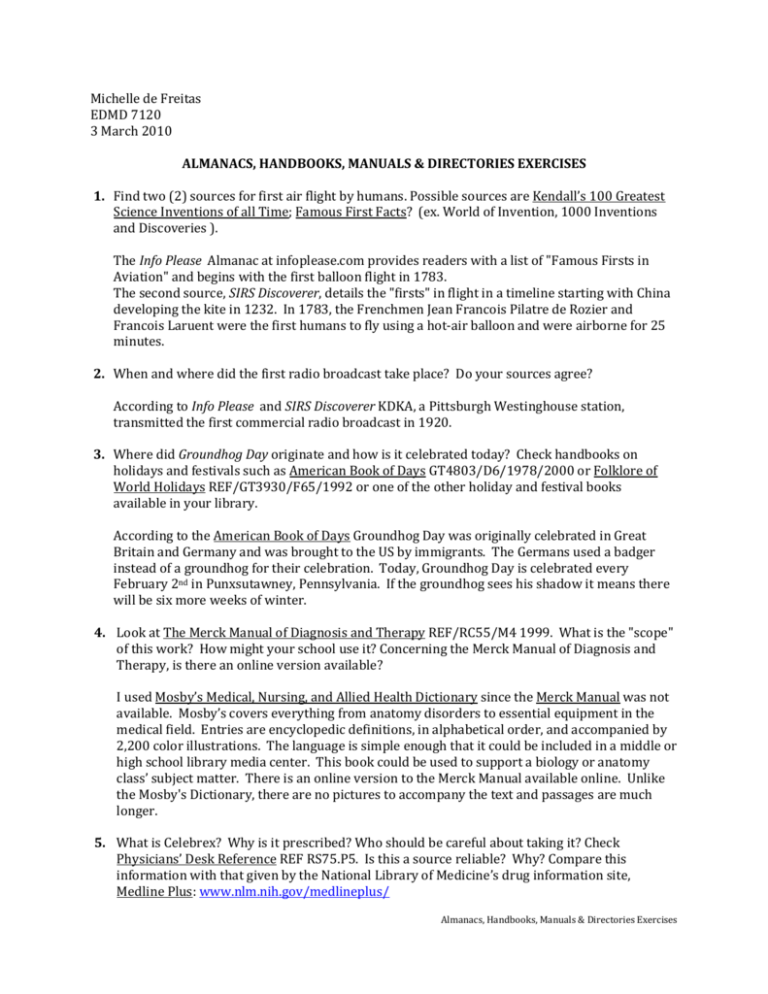
Michelle de Freitas EDMD 7120 3 March 2010 ALMANACS, HANDBOOKS, MANUALS & DIRECTORIES EXERCISES 1. Find two (2) sources for first air flight by humans. Possible sources are Kendall’s 100 Greatest Science Inventions of all Time; Famous First Facts? (ex. World of Invention, 1000 Inventions and Discoveries ). The Info Please Almanac at infoplease.com provides readers with a list of "Famous Firsts in Aviation" and begins with the first balloon flight in 1783. The second source, SIRS Discoverer, details the "firsts" in flight in a timeline starting with China developing the kite in 1232. In 1783, the Frenchmen Jean Francois Pilatre de Rozier and Francois Laruent were the first humans to fly using a hot-air balloon and were airborne for 25 minutes. 2. When and where did the first radio broadcast take place? Do your sources agree? According to Info Please and SIRS Discoverer KDKA, a Pittsburgh Westinghouse station, transmitted the first commercial radio broadcast in 1920. 3. Where did Groundhog Day originate and how is it celebrated today? Check handbooks on holidays and festivals such as American Book of Days GT4803/D6/1978/2000 or Folklore of World Holidays REF/GT3930/F65/1992 or one of the other holiday and festival books available in your library. According to the American Book of Days Groundhog Day was originally celebrated in Great Britain and Germany and was brought to the US by immigrants. The Germans used a badger instead of a groundhog for their celebration. Today, Groundhog Day is celebrated every February 2nd in Punxsutawney, Pennsylvania. If the groundhog sees his shadow it means there will be six more weeks of winter. 4. Look at The Merck Manual of Diagnosis and Therapy REF/RC55/M4 1999. What is the "scope" of this work? How might your school use it? Concerning the Merck Manual of Diagnosis and Therapy, is there an online version available? I used Mosby’s Medical, Nursing, and Allied Health Dictionary since the Merck Manual was not available. Mosby’s covers everything from anatomy disorders to essential equipment in the medical field. Entries are encyclopedic definitions, in alphabetical order, and accompanied by 2,200 color illustrations. The language is simple enough that it could be included in a middle or high school library media center. This book could be used to support a biology or anatomy class’ subject matter. There is an online version to the Merck Manual available online. Unlike the Mosby's Dictionary, there are no pictures to accompany the text and passages are much longer. 5. What is Celebrex? Why is it prescribed? Who should be careful about taking it? Check Physicians’ Desk Reference REF RS75.P5. Is this a source reliable? Why? Compare this information with that given by the National Library of Medicine’s drug information site, Medline Plus: www.nlm.nih.gov/medlineplus/ Almanacs, Handbooks, Manuals & Directories Exercises Celebrex is the generic trade-name for the NSAID Arthotec. It is prescribed to arthritis patients as it is an anti-inflammatory medication. It should not be prescribed to pregnant women if possible and if they are taking the medicine then they should stop taking it by their last term. The information on Medline Plus supported the information found in the Physician's Desk Reference. Both inform the reader that an NSAID medication can cause numerous side effects. 6. Identify a handbook*, manual, guide, directory, or almanac, besides those in questions 1-5, that could be a useful resource for your lesson plan. What kinds of information could students find in this resource? Are there other good sources for this type of information? This can be the source you bring to class and share. Painless Research Projects by Rebecca S. Elliott and James Elliot is a guide for middle school students that shows them how to create a research project. This book uses larger text, pictures, and bolded headings to direct students through the process. The guide advises them in how to choose a topic, how to locate resources in a library and online, and how to determine if a source will be helpful. Students could use this guide in my lesson to help them with locating and evaluating resources. 7. Who won the 2000 Winter Olympics gold medal for pairs figure skating? List the names and country please. What reference source did you use? In 1998 the Russian pair Oksana Kazakova & Artur Dmitriev won the gold medal and in 2002 Elena Berezhnaya & Anton Sikharulidze of Russia won, but after an IOC investigation Jamie Sale & David Pelletier of Canada were upgraded from silver to gold. (Info Please). Compare Encyclopedia of Alabama and Facts about the States for the following question: 1. What can you find out about Alabama from Encyclopedia of Alabama (available in Alabama collections in RBDL on the ground floor F324.3.E58, at Auburn Public Library and probably other public libraries as well as online) as compared with Facts about the States (or similar title) by J. N. Kane E/180/K/1993. The Facts about the States includes brief entries, tables and lists of information making it easy to search. The following subjects are covered for the state of Alabama: inhabitants, statehood, capital, state nicknames, seal, motto, location, state song, symbols, flag, geography and climate, national sites, history timeline, demographics, government and politics, finances, economy, environment, literature, culture and education, and unusual facts. It also provides a guide to fiction and nonfiction resources where the reader can gather more information. The Encyclopedia of Alabama has entries on the following information: agriculture, arts and literature, business and industry, education, folk life, geography and environment, government and politics, history, peoples, religions, science and technology, and sports and recreation. While I believe both the book and online resource are well-organized, with brief yet informative entries, the benefit of the Encyclopedia of Alabama is that it is electronic and will be up-to-date. The Facts about the States was printed in 1993 and most likely contains statistical information that is inaccurate. The benefit of this book though is that it offered a Almanacs, Handbooks, Manuals & Directories Exercises bibliography at the end of each section detailing fiction and nonfiction resources that one could access to gain more information. 2. Examine Statistical Abstract of the United States, it is much more convenient to use the online version and it is free at http://www.census.gov. Who publishes Statistical Abstract? Where do the statistics come from? What kinds of data can you find here and how could you use these in the social studies curriculum? Find one statistical table and discuss something you found interesting or surprising. I answered this questions on the in-class exercise. The following resources are likely to help with the questions above: World Almanac REF/AY67/N5/W7 Infoplease.com http://www.infoplease.com Time Almanac or New York Times Almanac Statesman's Yearbook REF/JA51/S7 [2007] Background Notes http://www.state.gov/r/pa/ei/bgn/ CIA World Factbook http://www.odci.gov The World Factbook provides information on the history, people, government, economy, geography, communications, transportation, military, and transnational issues for 266 world entities. The Reference tab includes: maps of the major world regions, as well as Flags of the World, a Physical Map of the World, a Political Map of the World, and a Standard Time Zones of the World map. (overview/history: https://www.cia.gov/library/publications/the-worldfactbook/docs/history.html) NOTE: For sources of handbooks other than those mentioned, see BIBLIOGRAPHIES Almanacs and Handbooks, in Blackboard–Bibliographies and Reference Sources – Information Sources for course; Katz, Handbooks chapter; AUBIECat “Your Topic” AND (handbooks or manuals). Almanacs, Handbooks, Manuals & Directories Exercises
